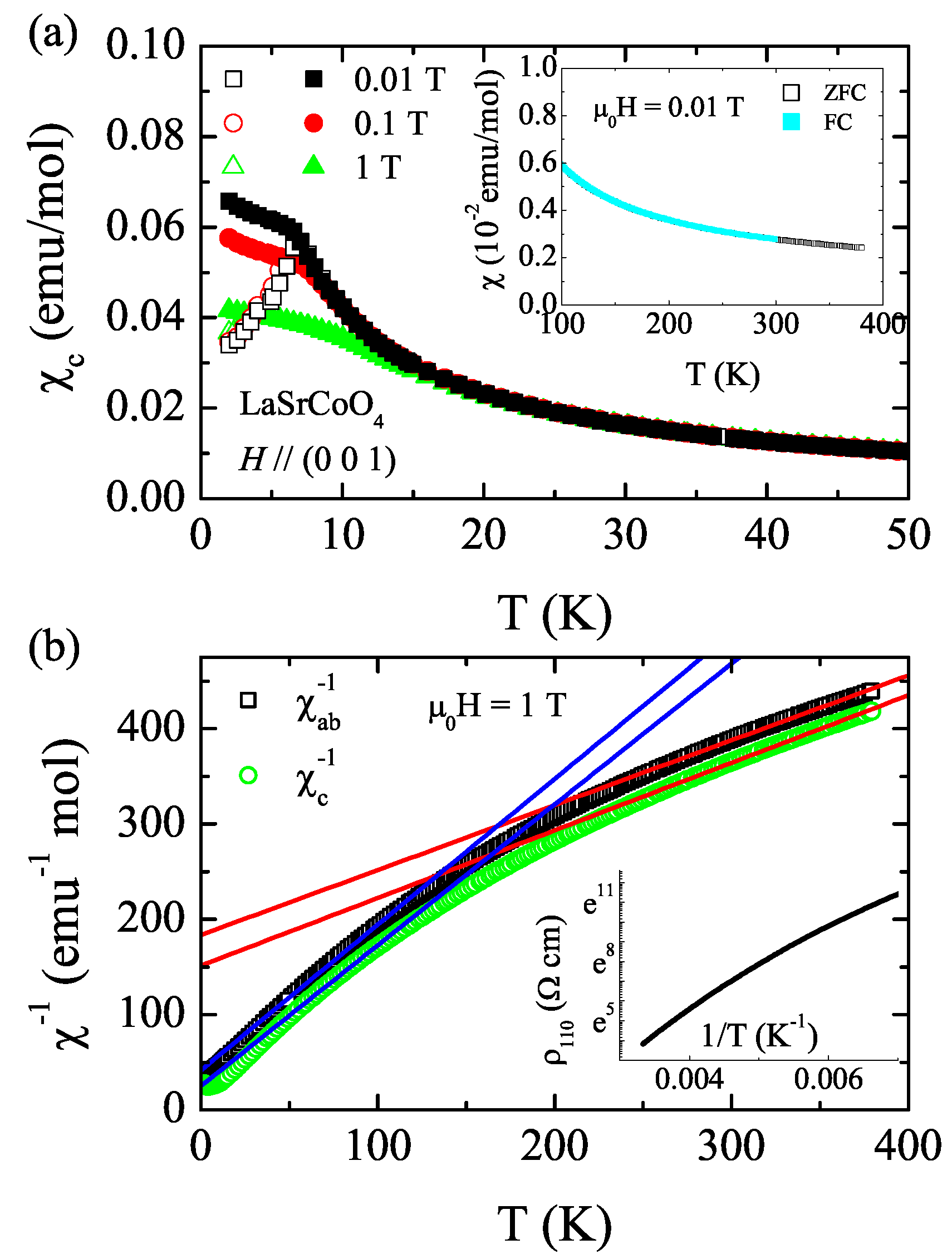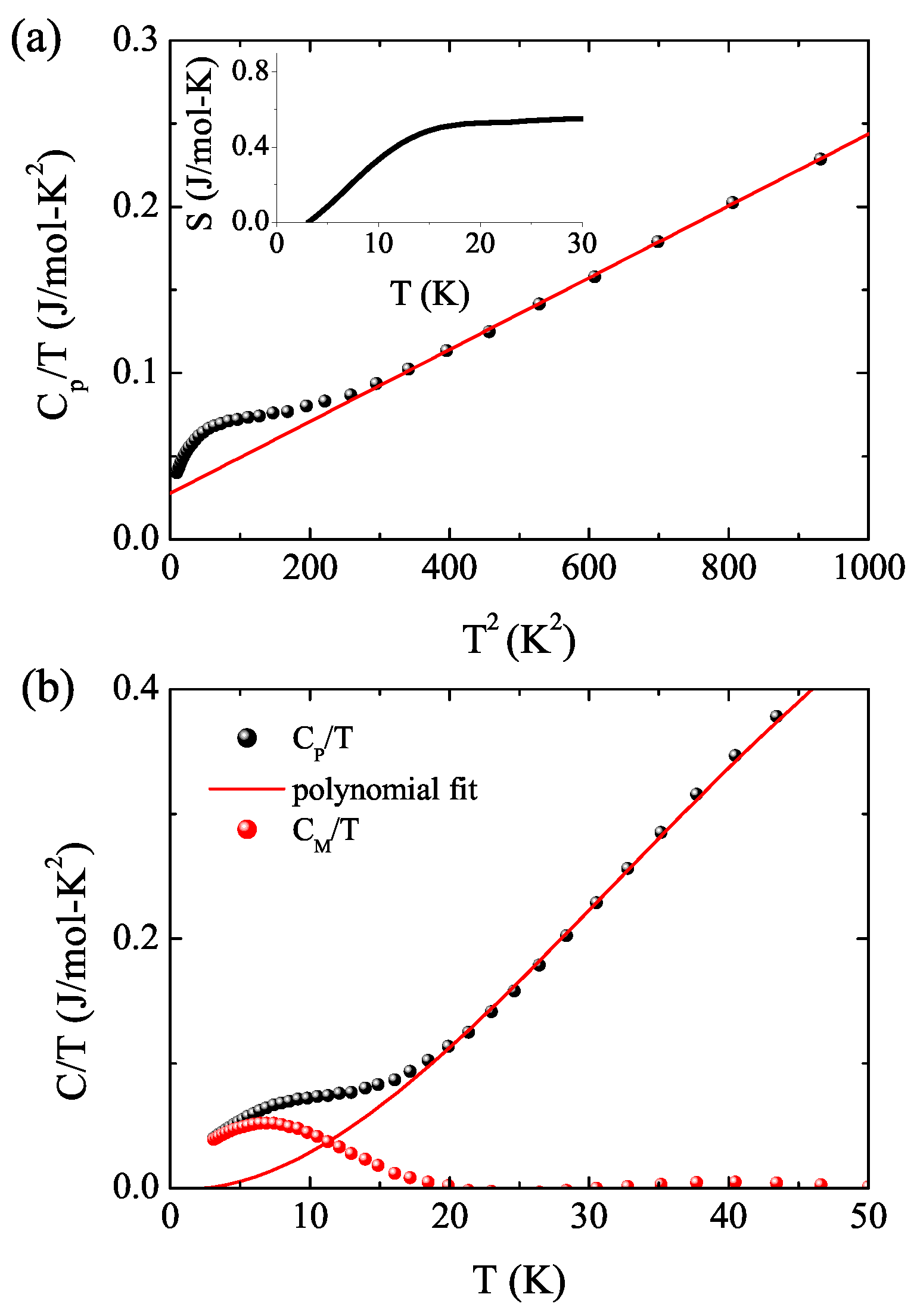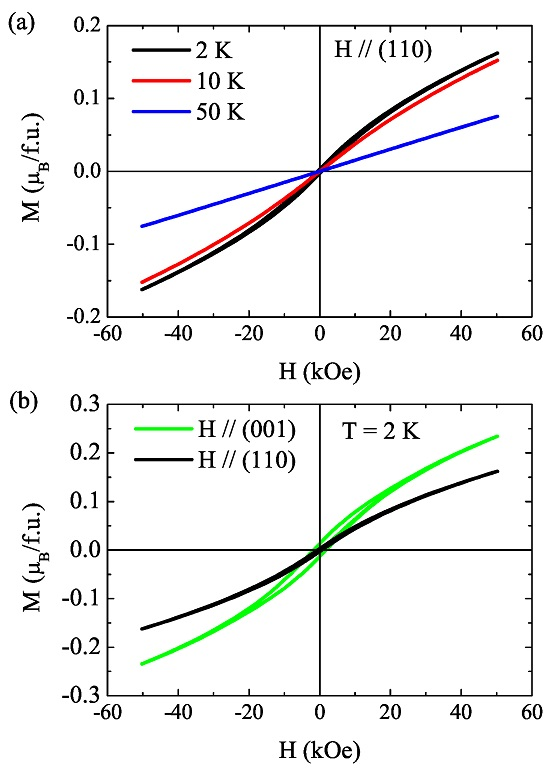1. Introduction
After the discovery of high temperature superconductivity (HTSC) in the cuprates, transition metal oxides with single-layer perovskite structure have attracted enormous attention. A universal property of these HTSC cuprates is an hourglass-shaped magnetic excitation spectrum in energy–momentum space. Therefore, the discovery of a similar spectrum in the isostructural (but insulating) cobaltates La
2−xSr
xCoO
4 (1/3 <
x < 1/2) has attracted considerable attention recently [
1,
2,
3].
Fermi surface effects can be neglected in these insulators, and therefore it was thought that charge stripes are responsible for the hourglass spectrum [
1]. Hard X-ray diffraction measurements for
x = 1/3 [
3] and neutron measurements for
x = 0.4 [
2], however, were not able to detect any charge stripes. Instead, checkerboard charge correlations were detected, and the hourglass spectrum could be explained in by a novel nano phase separation scenario based on La
2CoO
4-like undoped clusters and La
1.5Sr
0.5CoO
4-like checkerboard charge ordered clusters [
2,
3,
4,
5,
6]. Nevertheless, the discussion of the possible presence or absence of additional fractions of charge stripes in these cobaltates still continues [
7].
The undoped parent compound La
2CoO
4 is an antiferromagnetic insulator with a Néel temperature that amounts to
= 275 K [
8]. The Néel temperature is suppressed by hole doping
x and, finally, incommensurate magnetic ordering appears for
x > 1/3 [
5]. At and below half-doping, the Co
3+ ions are in the nonmagnetic (S = 0) low-spin (LS) state [
5,
9,
10], and a partial population of the (S = 2) high-spin (HS) state was observed for higher Sr-concentrations
x [
5]. Additionally, for 1/2 <
x ≤ 0.9, the hour-glass shaped magnetic excitations disappear [
5], which was interpreted as an indication of the importance of nearest-neighbouring exchange interactions (within undoped Co
2+ clusters) for generating the upper part of the hour-glass spectrum [
5]. So far, single crystals with Sr-content
x = 1 (i.e., LaSrCoO
4) were not investigated in detail, due to the difficulties in growing sizeable single crystals for inelastic neutron scattering experiments that also have pure Co
3+ oxidation states.
Studies reported in the literature on LaSrCoO
4 show controversial results. A study on polycrystals reveals a spin glass transition below about 10 K [
11]. Other studies on single- and polycrystalline samples indicate a paramagnetic state [
12,
13]. Note that there is no characterization of the Co valence state in these compounds. Insufficient Sr or oxygen content will result in Co
2+ impurities, and a small amount of Co
2+ impurities hampers the study of the intrinsic magnetic properties of LaSrCoO
4. Moreover, small amounts of other Ruddlesden-Popper phases (e.g., double-layer perovskite phases) might appear as intergrowths which dominate the magnetic properties of the studied samples. Single crystal growth of LaSrCoO
4 is reported in References [
12,
13], but the growing speed is rather fast and only small pieces of single crystalline samples were obtained. The lack of large impurity-free single crystals renders the investigation of LaSrCoO
4 by means of inelastic neutron scattering difficult. So far, X-ray absorbtion spectroscopy (XAS) measurements on polycrystalline Co
2+-free samples indicate a sizeable population of the Co
3+ HS state in LaSrCoO
4 [
5].
Here, we report the successful growth of large high-quality LaSrCoO4 single crystals using the high O2-pressure floating zone technique. X-ray diffraction and magnetic susceptibility measurements indicate the absence of impurity phases in our single crystals. A cusp at ∼7 K can be observed in zero-field-cooled (ZFC) susceptibility measurements. This feature can be suppressed by higher magnetic fields H. However, no λ-like anomaly is observed in specific heat measurements. Our observations are indicative of a spin-glass transition in LaSrCoO4, which is related to Co3+ ions in the HS state.
2. Results and Discussion
Single crystals of LaSrCoO
4 were grown using a high pressure floating zone furnace that can reach pressures of up to 150 bar. The starting materials La
2O
3, SrCO
3, and Co
3O
4 were mixed in stoichiometric molar ratios. After thorough grinding, the mixture was pressed into rods of ∼5 mm in diameter and up to ∼14 cm in length. These rods were sintered at 1100 °C in air for several days with several intermediate re-grindings. The subsequent crystal growth was performed under an O
2 pressure of 150 bar with a growth speed of 2 mm/h. Thus, black shiny single crystals of ∼60 mm length could be obtained (see
Figure 1). The crystal growth direction was close to the crystallographic [1 1 0]. The composition of the obtained single crystal was analyzed by inductively coupled plasma (ICP) measurements, and the molar ratio La:Sr:Co that was indicated by these measurements amounts to 1.012(3):1.003(3):1, which is close to stoichiometric. Therefore, the chemical composition LaSrCoO
4+δ could be confirmed within the expected accuracy of these measurements. The powder XRD pattern of our crushed and pulverized single crystals of LaSrCoO
4 are shown in
Figure 2a. A Rietveld fit was made using the
FullProf software. The crystal structure appears to be tetragonal, with space group
with lattice parameters
a = 3.80102(3) Å and
c = 12.47669(13) Å. No impurity phase was detectable in these XRD measurements. The refinement reliability factors are
= 4.74%,
= 6.08%, and
= 2.17.
The single crystal quality was further confirmed by Laue diffraction. The measured diffraction patterns are shown in
Figure 2b. All Bragg peaks could be indexed using the tetragonal symmetry with space group
I4/mmm.
Using soft X-rays at the synchrotron, XAS measurements have been performed on our LaSrCoO
4 single crystals at room-temperature (see
Figure 2c). The XAS spectrum of a CoO reference sample is shown below. Within the accuracy of these measurements, there are almost no (less than ∼1%) Co
2+ impurities visible in our XAS spectra. Additionally, we show LaCoO
3 reference spectra [
14], which are at the same energy as those of our LaSrCoO
4 single crystals. Hence, our XAS measurements confirm that we synthesized almost-pure Co
3+ LaSrCoO
4 single crystals.
The magnetic susceptibility
below 50 K is plotted in
Figure 3a. For measurement of
, magnetic fields with magnitudes of 0.01, 0.1, and 1 T were applied along the crystallographic
c-direction. As can be seen in the ZFC measurements of
, a cusp-like feature appears at
∼ 7 K concomitant with a bifurcation of ZFC and FC measurements.
can be suppressed with increasing magnetic field within the range of 0.01 T to 1 T from about 7.1 K to 4.0 K. Such a behavior might be indicative of a ferromagnetic or a spin glass transition. Furthermore, in our single crystals, any intergrowths of other Ruddlesden-Popper phases which are known to exhibit ferro-/ferri-magnetic transitions around 250 K [
11,
13] are absent in our single crystals, as is shown in the inset of
Figure 3a. All of these measurements indicate the high quality of our crystals.
The inverse magnetic susceptibility
of LaSrCoO
4 is shown in
Figure 3b. We have fitted the data to the Curie-Weiss function :
in two temperature ranges 50 K < T < 100 K and 250 K < T < 380 K. A temperature-independent term
was not included. These Curie-Weiss fits yield effective moments
= 3.43(22)
/f.u. and 2.28(13)
/f.u.,
= 3.36(20)
/f.u. and 2.33(15)
/f.u., as well as Weiss temperatures
= −269(2) K and −27.1(4) K,
= −213(2) K and −16.9(4) K for the high and low temperature regimes, respectively. Basically, these results would be in accordance with a partial population of the Co
3+ HS state, which increases with temperature.
In
Figure 3b, the anisotropy between
and
is also visible. An anisotropy of
χ has been already observed in the lower hole-doped regime of La
2−xSr
xCoO
4 with 0.3
0.8 [
15]. Based on the crystal field splitting for an elongated CoO
6 octahedron, the Co
3+ HS and IS state will result in
, while Co
2+ HS will result in
[
15]. This interpretation accounts for the anisotropy observed in the lower hole-doped regime of La
2−xSr
xCoO
4, which is mainly hosting Co
2+ HS ions and Co
3+ LS ions [
15]. From our structural refinement, the basal Co-O1 and apical Co-O2 distances amount to 1.9 Å and 2.1 Å, respectively. Our results indicate that the CoO
6 octahedron is elongated in the
c-direction. Thus, our observed anisotropy in
would be consistent with the occurrence of a Co
3+ HS or IS state. Wang et al. have shown that the IS state is unlikely to be the ground state of LaSrCoO
4 [
16]. Instead, a mixture of HS and LS states can be expected. It is well known that in LaCoO
3, the Co
3+ spin state changes at around 100 K from the LS state at low temperatures to the (thermally excited) HS state above roughly 100 K. Assuming that the spin only moment for Co
3+ HS ions amounts to 4.9
, we can roughly estimate the population of Co
3+ HS state from our Curie-Weiss fits: we obtain populations of about 20 % and 50 % for low temperatures (∼75 K) and room-temperature, respectively.
Figure 4a shows the isothermal in-plane magnetization measurements at 2 K, 10 K, and 50 K, respectively. A small hysteresis effect can be observed at 2 K with a remanence of 0.003
/f.u. and coercivity of about 550 Oe. The hysteresis effect is already absent for
T = 10 K (above
). The magnetization curve becomes straight at 50 K, as can be expected for a paramagnetic state. The magnetization is small and does not saturate yet. This suggests that the ground state of LaSrCoO
4 is a spin glass rather than a ferromagnetic state.
Figure 4b shows the direction-dependent comparison of the magnetization curves. The hysteresis effect is more pronounced in the
c-direction (with remanence of 0.013
/f.u. and coercivity of 1800 Oe). The magnetization along the
c-direction at the maximum applied magnetic field is about 40% larger than that along the [1 1 0]-direction, suggesting that the moment is preferably aligned along the
c-direction.
Heat capacity
measurements have been performed in order to study the low temperature magnetic anomaly. A
dependence of
is plotted in
Figure 5a. No
λ-like anomaly related to long-ranged magnetic ordering can be observed at
. The red curve shows a fit according to the equation
The fit gives a nonzero
γ = 0.028(1) J/mol-K
2 and
β = 2.16(2)
J/mol-K
4, thus yielding a Debye temperature
=
= 398 K (with the number of atoms
N and the ideal gas constant
R). LaSrCoO
4 shows an insulating behavior, as shown in the inset of
Figure 3b. This shows that the nonzero
γ term does not arise from an electronic contribution. Thus, it could be attributed to the spin glass state which has a highly degenerate ground state [
17,
18]. In order to estimate the magnetic contribution
, the phonon contribution has been subtracted from
. The latter contribution was obtained by a polynomial fit above 20 K (see
Figure 5b). The magnetic entropy
has been integrated from 3 K to 30 K. Temperature dependence of
is plotted in the inset of
Figure 5a. Assuming a Co
3+ HS population of ∼20 % at low temperatures, the expected entropy release amounts to 0.2
Rln(2S + 1) = 2.67 J/mol-K, while
at
is only 0.21 J/mol-K, and reaches 0.53 J/mol-K (∼20% of the total entropy) at 20 K. The large difference between the experimental and estimated value could be indicative for short-ranged magnetic fluctuations well above
and substantial zero-point entropy due to the highly degenerated ground state.
3. Materials and Methods
Floating zone single crystal growth has been performed using a one-mirror floating zone furnace from Scientific Instruments Dresden GmbH (Dresden, Germany). Using a sapphire cell, gas pressures of up to 150 bar can be applied during the growth in this mirror furnace that is equipped with a Xe lamp and with one single ellipsoidal mirror that focuses the light to the sample position within the sapphire cell.
Room temperature powder X-ray diffraction (XRD) measurements have been performed on a Bruker D8 Discover A25 (Karlsruhe, Germany) X-ray diffractometer using Cu Kα1 radiation.
Magnetic susceptibility measurements have been performed using a Quantum Design Magnetic Property Measuring System (MPMS) (San Diego, CA, USA).
Resistivity and specific heat capacity were measured in a Quantum Design Physical Property Measuring System (PPMS) (San Diego, CA, USA).
The soft X-ray absorption spectroscopy (XAS) of LaSrCoO4 were measured beamline 08B at the NSRRC in Taiwan.










